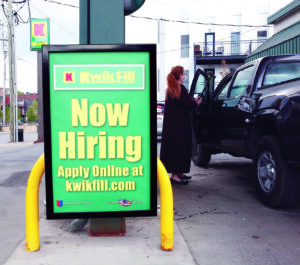Help wanted
Businesses struggle to find workers
By MICHAEL FORSTER ROTHBART • Special to www.AllOTSEGO.com

ONEONTA — A blue and white sign stands in the grass at the entrance to Southside Mall in the town of Oneonta: “JOBS! Cooperstown All-Star Village APPLY NOW.” In either direction, along the mile-long commercial strip from Wal-Mart to Home Depot, at least eight stores advertise available positions.
Outside Home Depot, in the afternoon Monday, May 17, two employees in masks help an older customer with curbside pickup, loading 2×4 boards over the passenger seat into his Buick sedan. The store has more than 70 employees and is now hiring people for eight positions, mostly part-time.
“We’re short six people, now that the college students just left,” said the older employee, who declined to be identified.
Next door at Hannaford, the grocery store has more than 120 employees and is hiring people part-time to work 30 to 36 hours per week. Starting pay is about $12.70 per hour, but there are opportunities for raises after three- and six-month reviews.
The Kwik Fill gas station is looking for employees to work first and second shifts, paying $13 an hour for 30 hours per week.
In downtown Oneonta, along four blocks of Main St., seven businesses have signs posted about job openings, including four restaurants, a tattoo parlor, one non-profit and one newly-opened store, Cloud Kitchen. The Latte Lounge was doing brisk business Monday, and is hiring staff to make drinks, work the grill and register, paying $12.50 an hour for eight-hour shifts.
Employment rates plummeted in Otsego County in April 2020, when the county lost 3,500 jobs in one month, data from the New York Department of Labor shows. Although local employment has climbed slowly but inconsistently since then, there were still 1,100 fewer jobs in the county in March 2021 than in March 2020.
Overall, Otsego County has fared better than many places in the state, according to Brion Acton, an economist for the Mohawk Valley office of the state Department of Labor. Before the pandemic, metropolitan areas had lower unemployment than rural counties, but the situation has reversed.
In the first year of the pandemic, through March, unemployment rose 7% in New York City, nearly 2% in many urban areas including Utica (1.9%) and Albany (1.6%), but less than 1% in rural areas such as Otsego County. The county had 6.3% unemployment in March 2021, the latest date for which statistics are available, compared to 5.5% a year earlier.
Outsego County Board of Representatives Chair David Bliss, R-Cherry Valley, Middlefield, Roseboom, said he is cautiously optimistic about Otsego County’s economy, citing the “substantial drop” in unemployment, increased vaccinations and the “lifting of COVID restrictions by the C.D.C.” Although he anticipates tourism in Cooperstown to be lower than normal this summer, “as more people are vaccinated, more people will be comfortable moving out and about traveling,” he said.
Nevertheless, Bliss said he remains concerned about some workers’ reluctance to return to work, and the prospect that higher wages could lead to inflation. “It seems that with the enhanced unemployment benefits, lengthened and enhanced, people don’t have an incentive to work if they can have their basic needs taken care of with unemployment,” he said.
“It’s a blessing and a curse,” Bliss said. “It’s nice to have that for those who really need it. But there’s a lot of people, you hear the stories, and I’ve heard firsthand, people say, ‘Well, why do I have to go back to work when I make just as much or more staying home?’”
Otsego County Representative Adrienne Martini, D-Oneonta, said Bliss is wrong about the reasons low-wage service jobs are going unfilled.
“We keep blaming people at the lowest rung of the ladder because they’re an easy target,” Martini said. “It’s pretty popular to say, ‘well these people are just inherently lazy, and they don’t want to work, and why would we give them incentives to not work?’”
Martini suggested the question should be flipped: “even if they do work, will it actually pay their bills and support their lives? And the answer, by and large, is no,” because minimum wage has not kept pace with the cost of living.
State Department of Labor statistics show that locally, the industries with the highest percentage job losses were in the “leisure and hospitality” sector, which includes accommodation, food services, arts, entertainment and recreation. In Otsego County, “leisure and hospitality declined 600 (jobs), or -23.1% since March 2020,” said Acton. “Using private sector employment as a benchmark, we see that the education and health services industry has fared better since March 2020, while leisure and hospitality has struggled.”
The largest employers in the county are in education and health services. Before COVID, one third of the Otsego County civilian workforce was employed in these fields, about 9,760 employees total, according to a report published by Otsego Now. Initially, 1,500 of those jobs were eliminated, but half those jobs have since returned.

